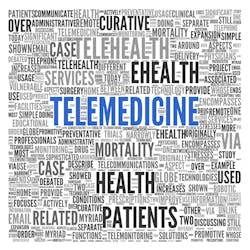Legal Considerations for Telehealth in the Age of the Coronavirus Pandemic
In the middle of a pandemic and with instructions from all levels of government to practice social distancing, visiting your healthcare provider virtually may seem like an obvious choice. And yet, a patchwork of federal and state regulations governing telehealth has complicated such visits.
As just one example, licensure of physicians is on a state-by-state basis. Each state has its own regulations making it difficult to implement a national telemedicine program. Adding to that are limits on physicians being able to treat patients in a state in which they are not licensed, as well as different state drug prescription and privacy laws.
COVID-19, however, has underscored the necessity for a more national approach, at least to telehealth coverage and reimbursement, as seen in the Telehealth Services During Certain Emergency Periods Act of 2020. This is a part of the larger Coronavirus Preparedness and Response Supplemental Appropriations Act of 2020 (the “Act”), signed into law on March 6, 2020. As to telehealth services, the Act gives the U.S. Department of Health & Human Services (HHS) the authority to temporarily waive certain existing limitations on Medicare coverage and payment for telehealth services to Medicare beneficiaries. It is not limited to COVID-19 and all currently approved telehealth codes can be used.
As a brief summary, the Act: (1) waives Medicare’s originating site and geographic requirement (that telehealth services be performed in a qualifying rural area at one of CMS’ qualifying originating sites), which allows telehealth services to be provided at any location within a defined “emergency area” during a defined “emergency period”; (2) eligible telehealth services under the waiver can only be performed by a “qualified provider” defined in the Act to include the same list of physicians and practitioners authorized under existing telehealth statutes and regulations, but the rendering physician’s or practitioner’s or his or her practice (as determined by tax identification number) must have furnished services to the patient at issue for which payment under Medicare was made within the prior three-year period for services to be reimbursable under the waiver; and (3) telehealth services can be provided via phone, but only if the phone has audio and video capabilities and can be used for two-way, real-time interactive communication.
On March 17, 2020, HHS did issue certain limited waivers. HHS waived the originating site and geographic requirement in the Act. It also waived the requirement that a patient have a prior established relationship with a particular physician or practitioner. HHS also waived penalties for HIPAA violations for providers serving patients in good faith through the use of telephones with audio and video capabilities even if those telephones are not HIPAA compliant. As further clarification, the Office of Civil Rights (OCR) will allow use of FaceTime, Facebook Messenger, Google Hangouts, or Skype, but would not allow more public facing applications such as Facebook Live, Twitch, and TikTok.
The length of these waivers is not yet known. And, most other requirements under existing Medicare telehealth statutes and regulations remain in place, which means varied reimbursement by state. While commercial payors are waiving telehealth visit copays, each still varies in rates reimbursed for telehealth versus in-office visits.
Moreover, once these waivers are rescinded, health care practitioners must still address a host of other issues in developing a telemedicine program including licensure in states in which they are servicing patients, data privacy and security (including that all communications methods are HIPAA-compliant), and applicability of other healthcare laws such as the Anti-Kickback Statute and Stark Law. As to licensing, the Interstate Medical Licensure Compact aims to address with an agreement in which licensed physicians can qualify to practice medicine across state lines within the Compact if they meet agreed upon eligibility requirements. More than half the states in the U.S. have passed legislation to join the Compact. Doing so will create an easier pathway to offering telemedicine services across state lines. Telehealth services can be convenient and accessible and an effectively designed program now meeting all of the complex regulatory issues will ensure that readiness for future infectious diseases is in place.
Although developing a telemedicine platform should be a necessary part of any practice, healthcare providers should not do so on an improvised basis and without considering all of the legal risks. Foremost is avoiding the compromise of any patient's privacy and ensuring that the use of any platforms has security safeguards in place to protect against hacking or other cyber threats.
Telemedicine is unlikely to entirely replace diagnostic or in-person testing, but in times of crisis, it can be an effective way to pre-screen cases without burdening emergency rooms and doctor's offices and delaying care. It also minimizes exposure to health care workers whose services we cannot afford to be without in addressing large numbers of infectious cases, as well as exposure to the community at large. As seen with COVID-19, these virtual visits are being used to assess severity of symptoms and determination of whether an in-person visit is needed.
Even after a diagnosis, providers can use remote monitoring to keep tabs on patients recovering at home to ensure that they are keeping to recommended therapies and taking prescribed medications. It also limits use of personal protective equipment (PPE) except in the most urgent cases. In its recently published guidance, the World Health Organization recommended telemedicine to avoid widespread, inappropriate use of PPE, citing that the global supply of masks and respirators for COVID-19 cases is insufficient, and capacity for further production limited. Although the guidance was driven by concerns about COVID-19, it does provide strategies useful for future cases.
As COVID-19 has demonstrated, misinformation is easy to spread especially as it relates to novel viruses. In that way, telemedicine offers a platform to improve education and treatment to those in areas without access to infectious disease physicians. These physicians can connect with local providers to assist and educate on program management, protocol development, surveillance, diagnosis, and monitoring. Mentorship is increased to rural and underserved areas, and to clinicians and non-clinicians alike. Educational opportunities increase because of easier access to consultation and review of cases.
As the response to the coronavirus pandemic continues to evolve, it is imperative that healthcare providers stay informed about the latest legal developments that may affect their practices, both in-person and with the use of telehealth programs and services. The usefulness and practicality of telehealth during COVID-19 will hopefully demonstrate that it can be a tool that can serve patient visits in the future, even without a crisis.
Monica Vir is a partner with Lindabury, McCormick, Estabrook & Cooper, P.C. (www.lindabury.com), a Westfield, NJ-based law firm. She is a member of the New Jersey State Bar Association, American Health Lawyers Association and Association for Corporation Growth in New Jersey and has significant experience providing legal counsel to healthcare facilities and physician practices.


